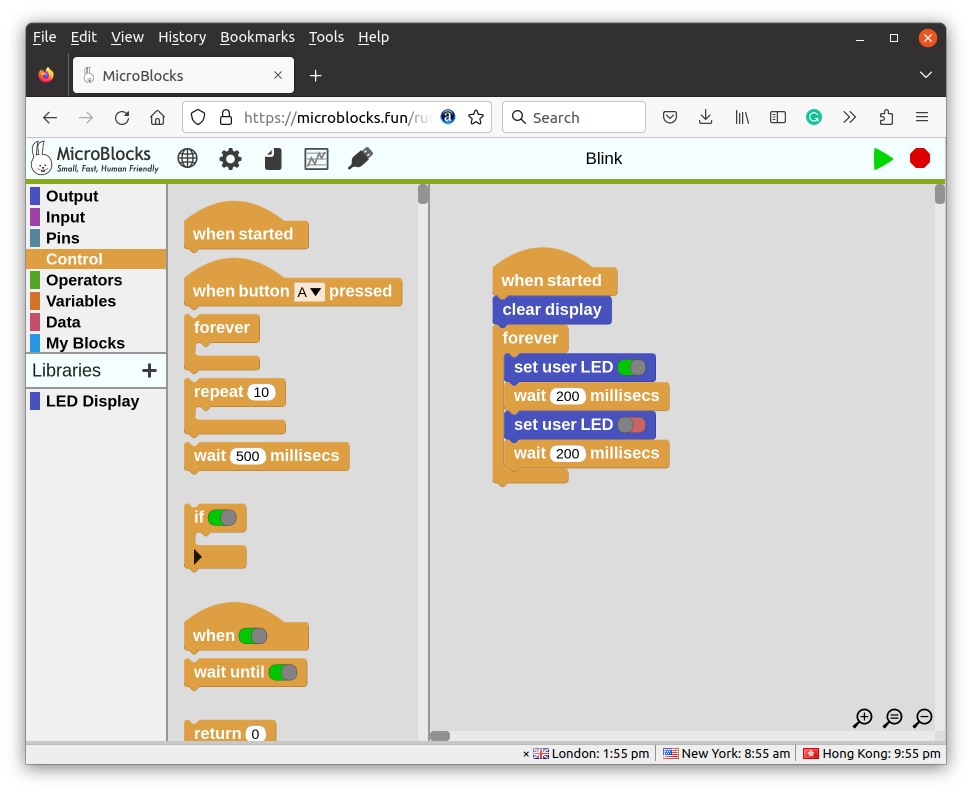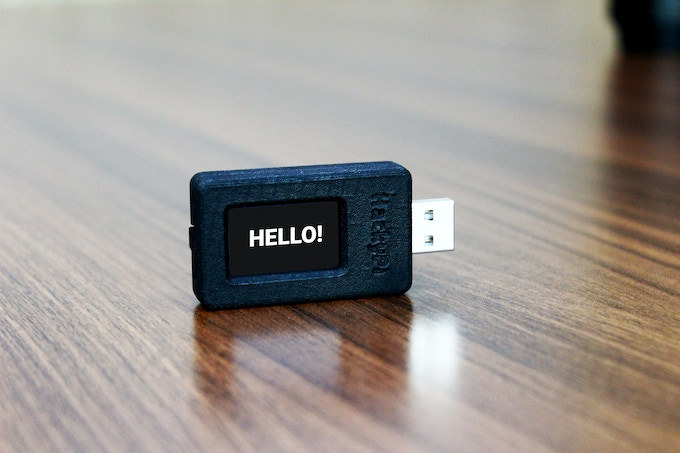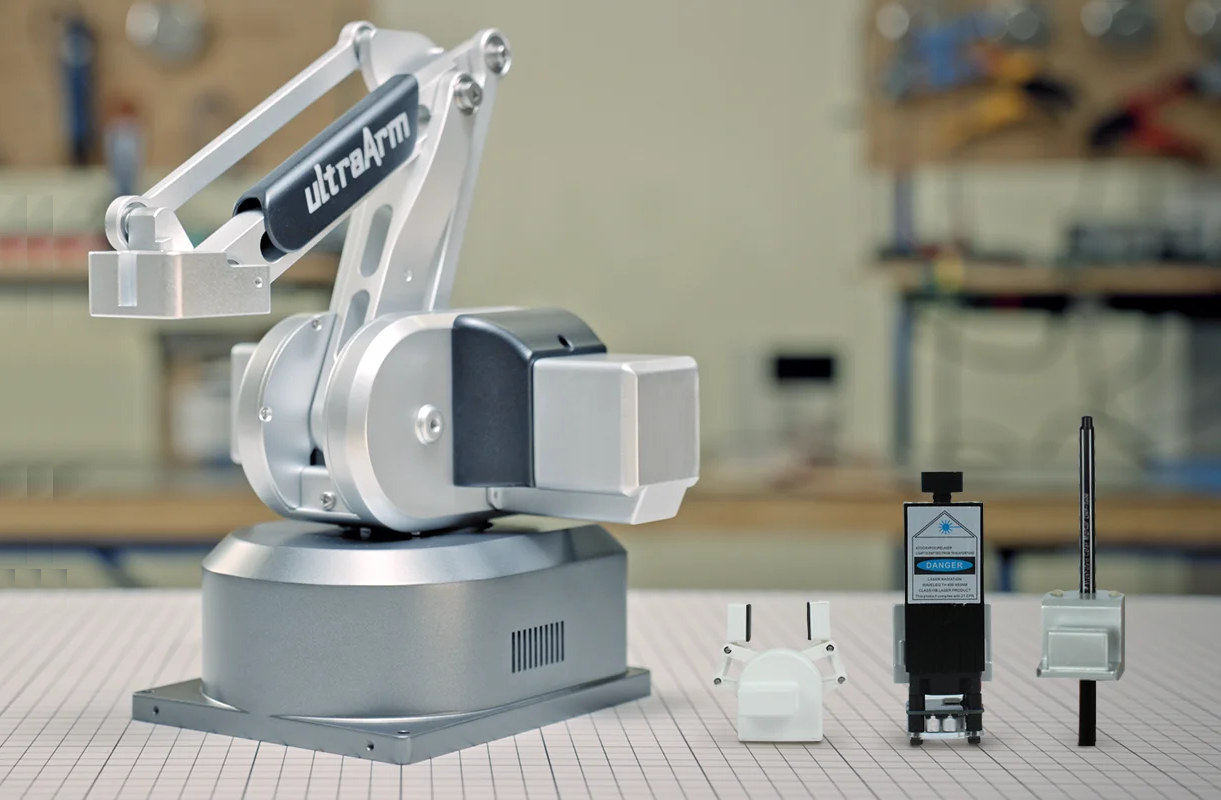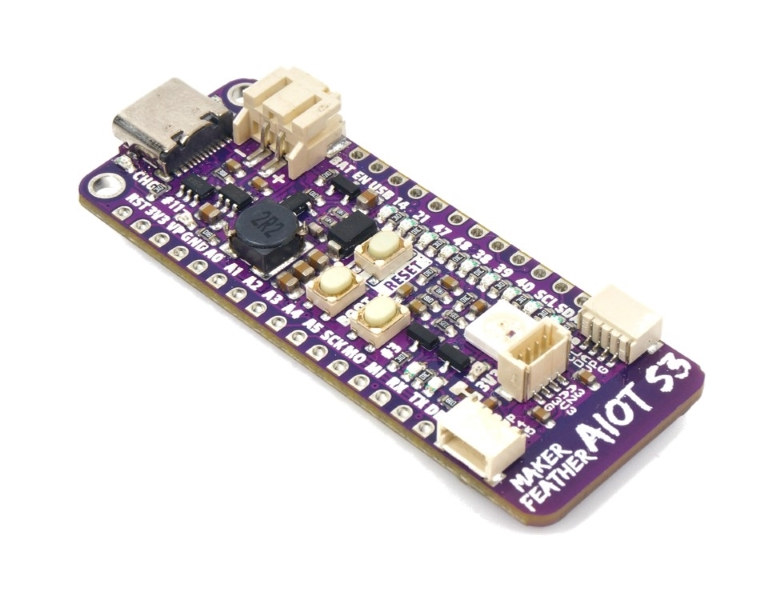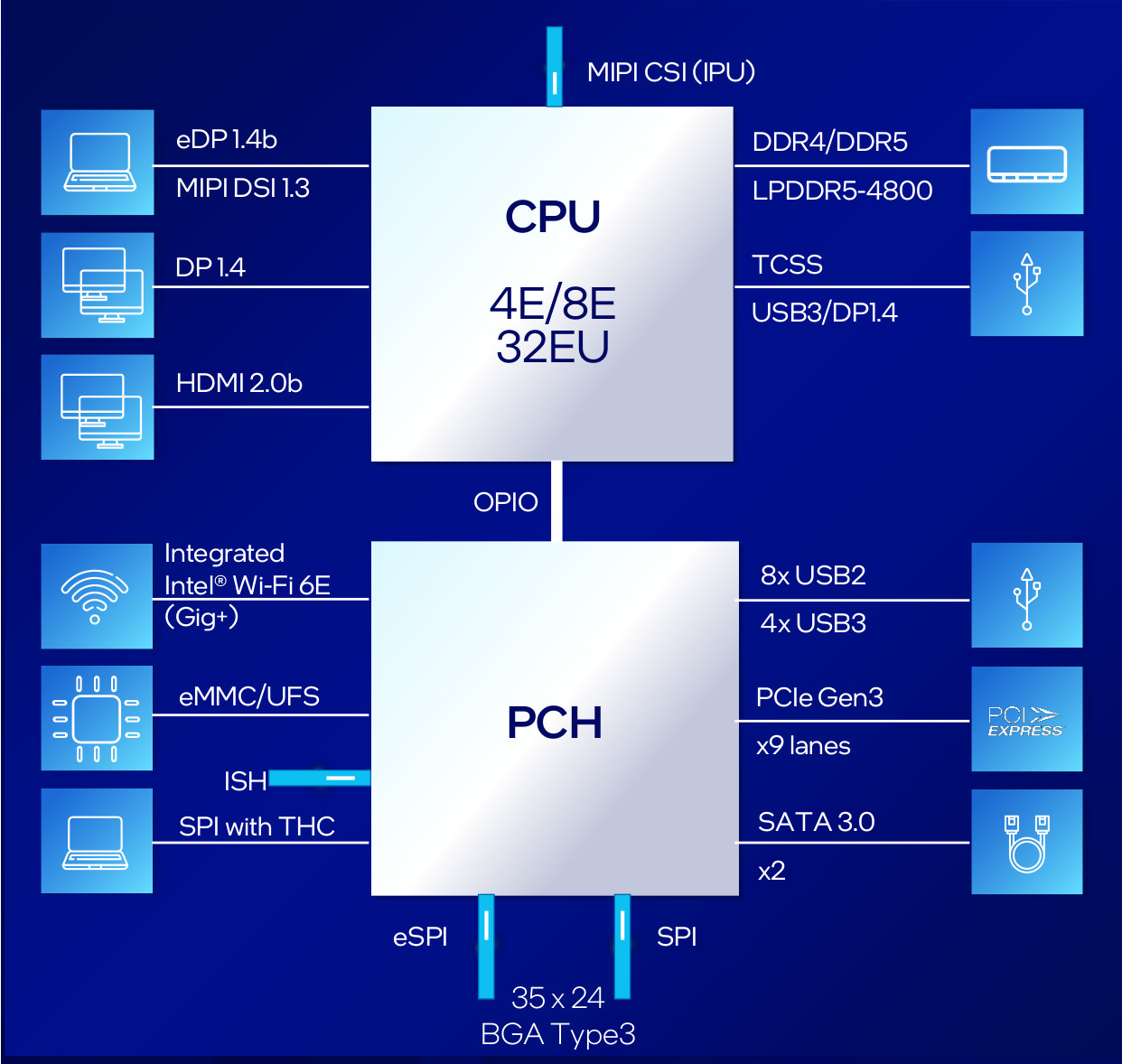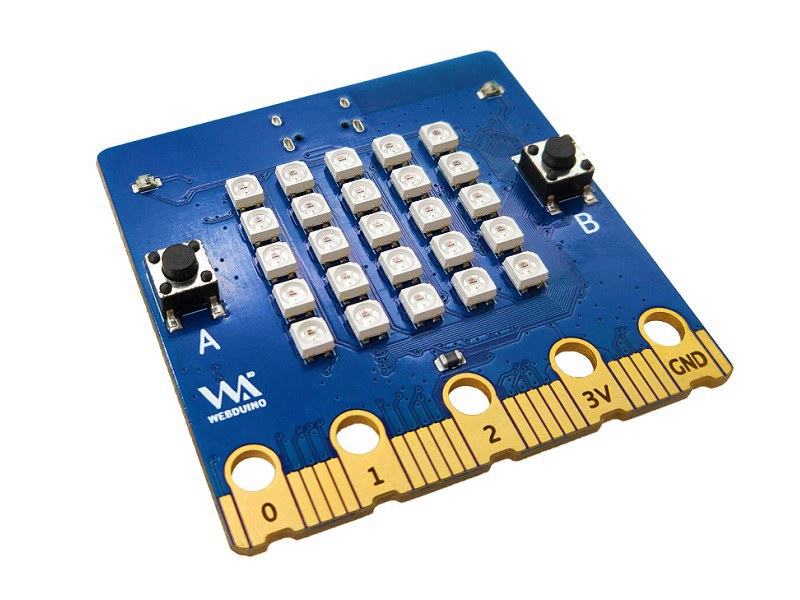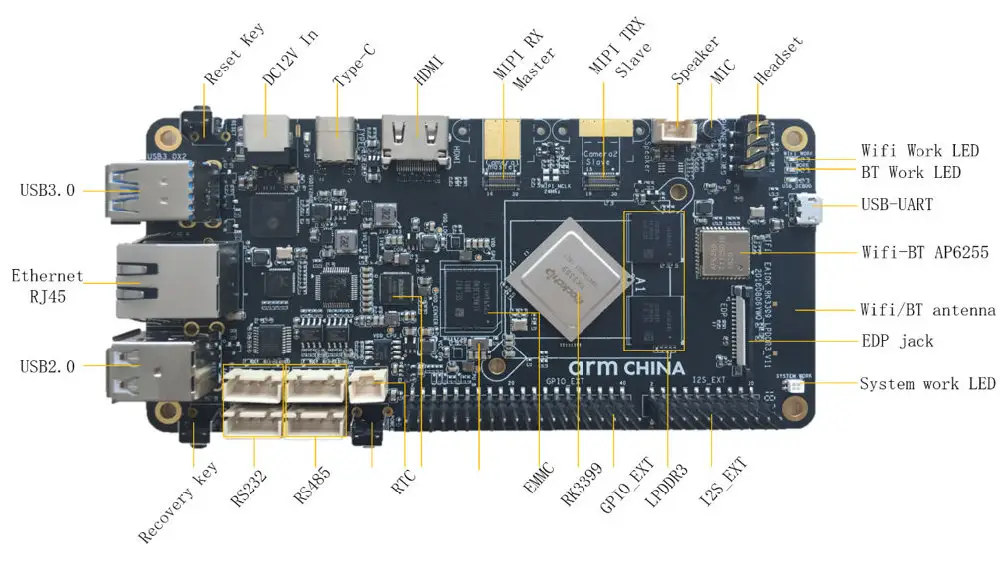MicroBlocks is a visual programming IDE for 32-bit microcontrollers currently supporting the BBC Micro:bit V1/V2, Calliope mini (aka the German Micro:bit), Adafruit Circuit Playground Express and Bluefruit, Raspberry Pi Pico and Pico W, and various other boards including ESP32 and ESP8266-based boards. I discovered MicroBlocks in the list of talks for FOSDEM 2023, and although it did not make it to my virtual schedule, I thought it was interesting to look into and write about it. In their upcoming FOSDEM talk, Bernat Romagosa and Kathy Giori refer to MicroBlocks as small, fast, and human-friendly with development guided by four guiding principles: liveness, parallelism, portability, and autonomy. The IDE is inspired by Scratch, and as such, looks very similar to other visual programming interfaces I have used over the years. You can launch MicroBlocks from Google Chrome or Microsoft Edge on a PC (not a mobile device) without having to install […]
HackyPi Raspberry Pi RP2040 USB dongle serves as an educational “hacking” tool (Crowdfunding)
SB Components’ HackyPi is a Raspberry Pi RP2040-based USB dongle whose main purpose is to teach ethical hacking and coding programs, in other words, some sort of portable educational hacking tool. The small USB stick features a 1.14-inch color LCD, a MicroSD card to store data such as scripts and photos, and a button to enable programming like on other Raspberry Pi RP2040 boards. HackyPi specifications: MCU – Raspberry Pi RP2040 dual-core Cortex-M0+ microcontroller @ 133 MHz with 264KB SRAM Storage – QSPI flash, MicroSD card slot Display – 1.14-inch color LCD with 240 x 135 resolution USB – 1x USB 1.1 Type-A port Misc – Boot “Initiate Program” button Power Supply – 5V via USB port Dimensions – 55.04 x 23.20mm SB Components says the HackyPi USB dongle can be programmed with Raspberry Pi Pico C/C++ and MicroPython SDKs as well as CircuitPython, and they will release hardware design […]
ultraArm P340 Arduino-based robotic arm draws, engraves, and grabs
Elephant Robotics ultraArm P340 is a robot arm with an Arduino-compatible ATMega2560 control board with a 340mm working radius whose arm can be attached with different accessories for drawing, laser engraving, and grabbing objects. We’ve previously written and reviewed the myCobot 280 Pi robotic arm with a built-in Raspberry Pi 4 SBC, but the lower-cost ultraArm P340 works a little differently since it only contains the electronics for controlling the servos and attachments, and needs to be connected to a host computer running Windows or a Raspberry Pi over USB. ultraArm P340 specifications: Control board based on Microchip ATMega2560 8-bit AVR microcontroller @ 16MHz with 256KB flash, 4Kb EEPROM, 8KB SRAM DOF – 3 to 4 axis depending on accessories Working radius – 340mm Positioning Accuracy – ±0.1 mm Payload – Up to 650 grams High-performance stepper motor Maximum speed – 100mm/s Communication interfaces – RS485 and USB serial Attachment […]
Maker Feather AIoT S3 – An ESP32-S3 board programmable with CircuitPython or Arduino
Cytron Maker Feather AIoT S3 is an ESP32-S3 board compatible with the Adafruit Feather form factor and suitable for makers and STEM education with features like LEDs for GPIOs, a buzzer, expansion headers and connectors, and support for CircuitPython & Arduino. The WiFi and Bluetooth LE IoT board also supports LiPo and Li-Ion batteries, includes a USB Type-C port for power/charging and programming, and a few buttons. It’s suitable for machine learning thanks to the vector extensions found in the ESP32-S3 microcontroller. Maker Feather AIoT S3 specifications: Wireless module – Espressif ESP32-S3-WROOM-1-N8R8 module with ESP32-S3 dual-core LX7 microprocessor @ up to 240 MHz with Vector extension for machine learning, 8MB FLASH, 8MB PSRAM, WiFi 4 and Bluetooth 5 LE/Mesh USB – 1x USB Type-C port power and programming Expansion 2x GPIO headers compatible with Adafruit Feather form factor and FeatherWing add-on boards 3x Maker Ports compatible with Qwiic, STEMMA QT, […]
Meet Intel Processor and Core-i3 N-series “Alder Lake N-series” processors
Pentium and Celeron brands are officially dead with Intel introducing the Alder Lake-N family comprised of “Intel Processor” and Core-i3 N-series processors based on the Gracemont “Efficiency” cores found in Alder Lake hybrid processors. Some of the details about the Intel Processor N100 and N200 processors were leaked last fall, followed by the Core i3-N300 and Core i3-N305, but at least it is now official, and we have more details so let’s dig into it. Alder Lake N-series key features and specifications: CPU – Up to 8x Gracemont Efficient cores for Core i3 N-series processor, and up to 4x with Intel Processor processor GPU – Intel UHD graphics with AV1 decode support Memory I/F – LPDDR5-4800, DDR4, DDR5 Storage I/F – eMMC/UFS 2.1 flash, 2x SATA 3.0 Video Output eDP 1.4b / MIPI DSI 1.3 DisplayPort 1.4 HDMI 2.0b Up to 3x independent displays Camera I/F – MIPI CSI Networking […]
Banana BPI-Bit-S2 BBC Micro:bit compatible board supports WiFi
Banana BPI-Bit-S2 is a board for the education market that’s compatible with the BBC Micro:bit V2, but offers WiFi connectivity instead of Bluetooth LE through an Espressif Systems ESP32-S2 wireless microcontroller. The BPI-Bit-S2 succeeds the earlier Banana Pi BPI-Bit with ESP32 WiFi & BLE microcontroller that was a closer match to the original BBC Micro:bit than the new ESP32-S2 board for which I see little benefit, except for the slightly lower price tag. Banana BPI-Bit-S2 specifications: Wireless MCU – Espressif Systems ESP32-S2FN4R2 single core LX7 microcontroller with 320 kB SRAM, 2MB PSRAM, 4MB flash, 2.4 GHz WiFi connectivity LEDs – 25x RGB LED matrix USB – 1x USB Type-C port for power and programming Sensors – 2x light sensors, 1x thermistor sensor Expansion – 3x I/O rings, 3V/GND rings, 20-pin edge connector (compatible with BBC Micro:bit V2 design) with up to 16x GPIO, I2C, SPI, 3.3V, and GND Misc – […]
Elephant Robotics Christmas 2022 sales (Sponsored)
Elephant Robotics is back with another promotional event for Christmas 2022 selling educational robotic kits and toys with up to a $400 discount until December 26, 2022. The highest discount is for the Raspberry Pi 3-powered MarsCat selling for $999, or $400 less than the original price tag of $1,399, but the company also offers an $80 discount for all robotic arms from the company including the myCobot and mechArm robotic arms, myBuddy dual arm system, and myPalletizer compact 4-axis robotic arm, as well as the myAGV four-wheel drive vehicle. If you use the coupon code Xmas, you’ll get a $50 on the metaCat robotic plush toy / smart cat. Finally, all orders over $3,000 qualify for free shipping with the FREESHIP3000 coupon code. The exact same promotions are available on the Elephant Robotics’ Amazon store. If you prefer doing your shopping on Aliexpress instead, Elephants Robotics has more Chrismas […]
Open AI Lab EAIDK-610 devkit targets computer vision education with OpenCV
Open AI Lab EAIDK-610 is an embedded AI development kit powered by a Rockchip RK3399 processor, recently added to Linux 6.1 and described as “popularly used by university students” in the kernel changelog. But I had never heard about it, and it turns out it’s because it’s popular with students in China, and most documentation is written in Chinese. The development board is equipped with 4GB LPDDR3, a 16GB eMMC flash, HDMI video output, Gigabit Ethernet and WiFi 5, a few USB ports, a 40-pin GPIO header, and more. EAIDK-610 specifications: SoC – Rockchip RK3399 System Memory – 4GB LPDDR3 Storage – 16GB eMMC flash and MicroSD card slot Video Output HDMI 2.0 up to 4Kp60 MIPI DSI up to 1280×720 @ 60 fps 4-lane eDP 1.3 Audio – Speaker header, built-in microphone, 3.5mm audio jack, I2S header, digital audio via HDMI Camera I/F – 2x MIPI CSI up to […]


